The Smartweed is in blossom, and that’s a good thing because that almost helps with its identification. I say almost because there are a lot of variations within the species. This however does help botanists argue endlessly about the various species as well as changing names. There are three locally and all are peppery hence “smart” weed. It used to be called “arsesmart.” At least one of the peppery species grows nearly everywhere in North America except Utah, Colorado and Wyoming, too high or dry I presume as Smartweed likes to be damp.
While we wouldn’t want to harvest Smartweed from a flooded roadside ditch that is one place it likes to grow and one place where we can study it conveniently. It likes wet spots; sides of rivers and ponds, in swamps, over-watered lawns, ruts in woodsroads and roadside ditches. The genus, Polygonum, means many knees and the plant does bend slightly at each joint. The lance shaped leaves can sometimes take on a red hue. But the most important element of identification is a peppery burn that takes a few seconds to register on the palate. Oddly the genus is in the Buckwheat family which includes such species at the Sea Grape tree and the Dove Plum tree.
The leaves can be used as a seasoning though some people do have contact dermatitis with it. The blossoms are also peppery but bitter as well. My video on Smartweed is here. To read more about the Smartweed go here.
?“Yuck.”
That word lands in my mailbox regularly, sprinkled through like spice on an entree. It reminds me of what a great language English is.
 English is not some frou-frou glot of genteel nuances or unique sounds. And while it might have started out as German Lite it has borrowed so much from other languages that it’s the largest and most predominate tongue on Earth. But beyond that English is fit. It’s muscular, punchy, to the point. English has brawn. It works out, demands attention, and gets things done. Yelling EXTINGUISH THE CONFLAGRATION will not stir anyone to action. PUT OUT THE FIRE will. Latin just can’t hold a candelabra to English.
English is not some frou-frou glot of genteel nuances or unique sounds. And while it might have started out as German Lite it has borrowed so much from other languages that it’s the largest and most predominate tongue on Earth. But beyond that English is fit. It’s muscular, punchy, to the point. English has brawn. It works out, demands attention, and gets things done. Yelling EXTINGUISH THE CONFLAGRATION will not stir anyone to action. PUT OUT THE FIRE will. Latin just can’t hold a candelabra to English.
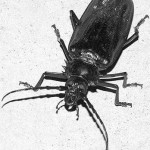 So yes, “yuck,” a taut, vigorous English word populates my emails. Why? The answer is the Acorn Grub video, the Bon Appetit video, articles on the edibility of dogs and cats, Guinea pigs, horses, alligator, armadillos, slugs and snails, earthworms, scorpions, spiders and some four dozen other insects such as the June Bug right. I know of a naturalist who starts each class on wild edibles by eating a live black beetle he finds in front of everyone. To him all black beetles are edible. “Yuck” you say. Perhaps. So powerful is that one word that several folks have sent just one word emails to me… Sometimes two words and they rhyme. Yuck is succinct. It tells me the writer’s mental state and their opinion, which is fine. In matters of taste there is no debate. Only matters of truth are worthy of debate. And just as some find these critters “yucky” so to do many find eating weeds “yucky.” That reminds me of a commercial on the radio.
So yes, “yuck,” a taut, vigorous English word populates my emails. Why? The answer is the Acorn Grub video, the Bon Appetit video, articles on the edibility of dogs and cats, Guinea pigs, horses, alligator, armadillos, slugs and snails, earthworms, scorpions, spiders and some four dozen other insects such as the June Bug right. I know of a naturalist who starts each class on wild edibles by eating a live black beetle he finds in front of everyone. To him all black beetles are edible. “Yuck” you say. Perhaps. So powerful is that one word that several folks have sent just one word emails to me… Sometimes two words and they rhyme. Yuck is succinct. It tells me the writer’s mental state and their opinion, which is fine. In matters of taste there is no debate. Only matters of truth are worthy of debate. And just as some find these critters “yucky” so to do many find eating weeds “yucky.” That reminds me of a commercial on the radio.
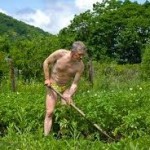 After some typical radio machinations a woman announces that she puts (let’s say) Weeds-Be-Dead on her garden so her husband won’t have to weed it for six months. Now she says she can enjoy her garden rather than always watching him weed… understandable… But you and I know that many of those yucky weeds he’s removing are quite edible and should be in the kitchen. Weeding can be harvesting; the food is fresh, nutritious, unsprayed, unmodified genetically by man and close to free. But then there is the issue of attitude.
After some typical radio machinations a woman announces that she puts (let’s say) Weeds-Be-Dead on her garden so her husband won’t have to weed it for six months. Now she says she can enjoy her garden rather than always watching him weed… understandable… But you and I know that many of those yucky weeds he’s removing are quite edible and should be in the kitchen. Weeding can be harvesting; the food is fresh, nutritious, unsprayed, unmodified genetically by man and close to free. But then there is the issue of attitude.
There’s a quaint British detective series which involves an obese chef who is also a senior police detective. (Only the Brits can get away with funding and producing such a show theme.) In one program the main character’s job is to help protect and feed a rather nasty young woman who is to testify against her deadly husband. At the same time the detective-chef is having a difficult time getting quality herbs for his restaurant. The “safe” house where she is staying just happens to have fantastic herbs just growing out back which he discovers. There’s a wonderful exchange between the avuncular detective-chef and one of the young armed officers protecting the woman. It’s an attitude most of us have heard before. To see the 42-second clip click here.
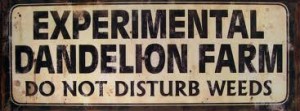 I am sure some folks who are now eating dandelions once viewed them as “yucky” and had the attitude of the young “copper” above. Eating weeds (and other things, too) is more than knowledge and experience. It’s also a matter of attitude.
I am sure some folks who are now eating dandelions once viewed them as “yucky” and had the attitude of the young “copper” above. Eating weeds (and other things, too) is more than knowledge and experience. It’s also a matter of attitude.
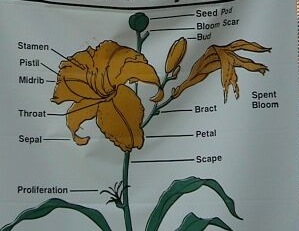 ? Botany Builder #17. Petals, sepals, tepal and bracts. Flower blossoms are usually defined from the outside in. There is some logic to this in that center parts used to be outer parts long ago, according to botanists. The only real confusing thing is that petals and sepals can look nearly identical. For example, daylily blossoms look like they have six petals. Actually they have three petals and three sepals (the sepals are slightly lower than the petals but colored the same.) Bracts are leafy protrusions below the sepals. Probably the most famous bracts are red bracts on Poinsettias at Christmas time (the blossoms are very tiny) Locally the Spotted Beebalm has pretty pink bracts in the fall. The word “Tepal” is used when botanist can’t tell where the petals stop and the sepals begin, meaning the distinction between the two is so indistinct they call the entire arrangement a tepal (among other loose uses of the term.) At any rate the parts line up from the outside in as bracts, sepals and petals, and when in botanical doubt, tepals. By the way, I would add that daylilies are fatal to cats. Even such a thing as licking daylily pollen off their fur can kill them.
? Botany Builder #17. Petals, sepals, tepal and bracts. Flower blossoms are usually defined from the outside in. There is some logic to this in that center parts used to be outer parts long ago, according to botanists. The only real confusing thing is that petals and sepals can look nearly identical. For example, daylily blossoms look like they have six petals. Actually they have three petals and three sepals (the sepals are slightly lower than the petals but colored the same.) Bracts are leafy protrusions below the sepals. Probably the most famous bracts are red bracts on Poinsettias at Christmas time (the blossoms are very tiny) Locally the Spotted Beebalm has pretty pink bracts in the fall. The word “Tepal” is used when botanist can’t tell where the petals stop and the sepals begin, meaning the distinction between the two is so indistinct they call the entire arrangement a tepal (among other loose uses of the term.) At any rate the parts line up from the outside in as bracts, sepals and petals, and when in botanical doubt, tepals. By the way, I would add that daylilies are fatal to cats. Even such a thing as licking daylily pollen off their fur can kill them.
? Classes: Cassadaga has a nice little park and was added to my list of sites by request. Unfortunately, it always has the smallest classes though there is much to see there. Two plants should be mentioned. The first is kudzu, which many people have heard about but never seen. The state says it doesn’t grow there but it is epidemic there. To read about kudzu click here, to see a video on kudzu click here. The other is the Winged Yam, what I think of as the prime wild caloric staple here in Florida. At the Cassadaga class Saturday we found a large wing yam root. The vine is still died back from winter but some informed guessing helped us locate a root. Locally there are about the size of a football somewhere around 10 pounds. To see a video about the yam click here, to read the related article click here.
Easter Sunday was spent in the close-to-town wilderness of Wekiva State Park, more a native edibles class than a cosmopolitian weed class. The Wekiva forage used to be an easy four mile walk, two miles to Rock Spring Run through scrub and then two miles back through the swamp on an old logging road. The swamp portion has been closed. Still, it combines two very different environments, high and dry and low and wet. Makes for an interesting distribution of species. There’s also a few mother alligators about. While looking for plants I saw five deer and two wild turkeys which along with gigantic free-flowing springs is why the natives (and locals today) like the area. One of the more unique species we saw was Florida Pennyroyal. It is unrelated to the common pennyroyal though the aromatic oil is the same. The plant, which is nearly impossible to transplant, is found only in Florida and western parts of the East Indies. It is also monotypic, that is, the only species in its genus (that’s what botanists do when they can’t figure out what group to put a plant in. They create a new group of one.)
Saturday, April 14th, Mead Garden: 1500 S. Denning Dr., Winter Park, FL 32789. 9 a.m.
Sunday, April 15th, Wickham Park: 2500 Parkway Drive, Melbourne, FL 32935-2335, 9 a.m
? Budget Cut Benefits. 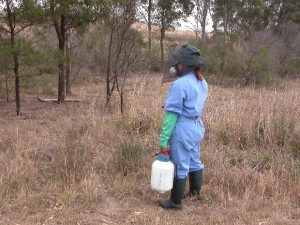 Two effects of the economic times are influencing foraging. First is an increase in the number of people who are putting food on the table by foraging. Think of it as a training calm before an economic storm. The other benefit is an increase in edible weeds.
Two effects of the economic times are influencing foraging. First is an increase in the number of people who are putting food on the table by foraging. Think of it as a training calm before an economic storm. The other benefit is an increase in edible weeds.
Because of tight budgets various agencies don’t have the money to pay for weed control as they did. Wild edibles that were often kept at bay by regular mowing or spraying are now flourishing. At many areas I haunt for edibles there are far more weeds than usual. It is an interesting example of how less is more.
There was a time when no resources were spent controlling nature. In return nature provided ample food for man to survive. Then came agriculture, then cities and eventually a human population that cannot survive without big agriculture. A century ago when most folks not only stopped foraging but started moving off the farm, they planted non-edible plants about their homes and cities. They even allocated money to keep nature in check, as if nature was a green enemy. We went from being part of nature to opposing it. Nature went from being a provider to being a pain. We turned on something that had sustained humanity for thousands of years. And more saliently, it was and perhaps is a pointless expenditure: Nature has far more resources than man and doesn’t need a bank account to get something done, such as growing more weeds.
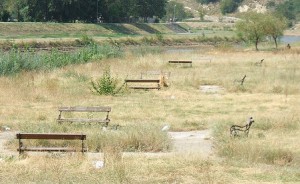 The areas I roam for wild edibles are just accessible now as they were last year and the year before. But less plants are being destroyed. Nature is responding and coming back with wild edibles: Ground cherries, peppergrass, blackberries, milkweed, yams, maypop, grain grasses. When we stop spending money battling nature, nature provides more food, for free, and there’s less pollution. That strikes me as a win win win and a lesson not to be forgotten if and when the economy recovers.
The areas I roam for wild edibles are just accessible now as they were last year and the year before. But less plants are being destroyed. Nature is responding and coming back with wild edibles: Ground cherries, peppergrass, blackberries, milkweed, yams, maypop, grain grasses. When we stop spending money battling nature, nature provides more food, for free, and there’s less pollution. That strikes me as a win win win and a lesson not to be forgotten if and when the economy recovers.
To donate to the Green Deane Newsletter click here.

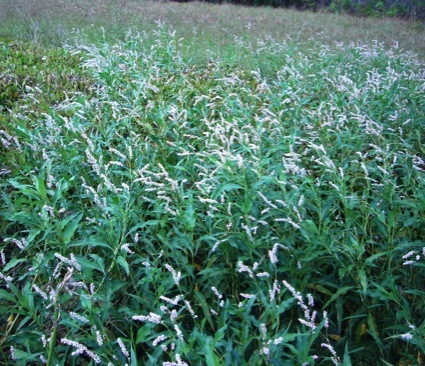
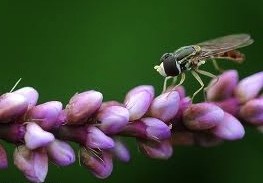
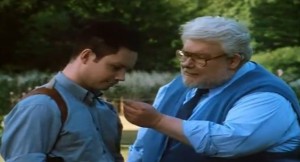
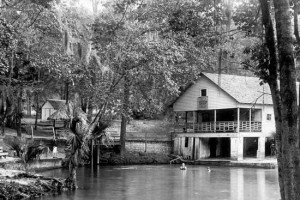

Thank you so much for sharing your knowledge. I am new to the thought of foraging and I am really enjoying learning about it. It adds a whole new element to my nature walks. I have not actually eaten anything yet. Im still reading and learning. I want to make sure that I don’t eat anything that I shouldn’t. 🙂 Thanks again.
Well said, Deane!
Back to weekly? I hope. Maybe I’m just spoiled! Thank you.
LOL! Great article. I had to tel lmy neighbor to mind his business the other day when he said I had “weeds” in my garden bed. I said yes I do, Crepis and Pellitory which are great in a salad or to eat now, try it. He laughed but didn’t eat the “weeds”. I said you pay to fertilize and then you spend time to mow your grass. Why? He said ” it looks good”. I said looking good is a matter of opinion, to be honest I think you are stupid for wasting money and polluting the lake outback. I had him thinking…He actually said I had a point.
Hello Green Dean do you have any info on air potatoes???? Thank you
I have three huge articles on them. Search for or look in the archive for Yam A, Yam B, and Yam C.